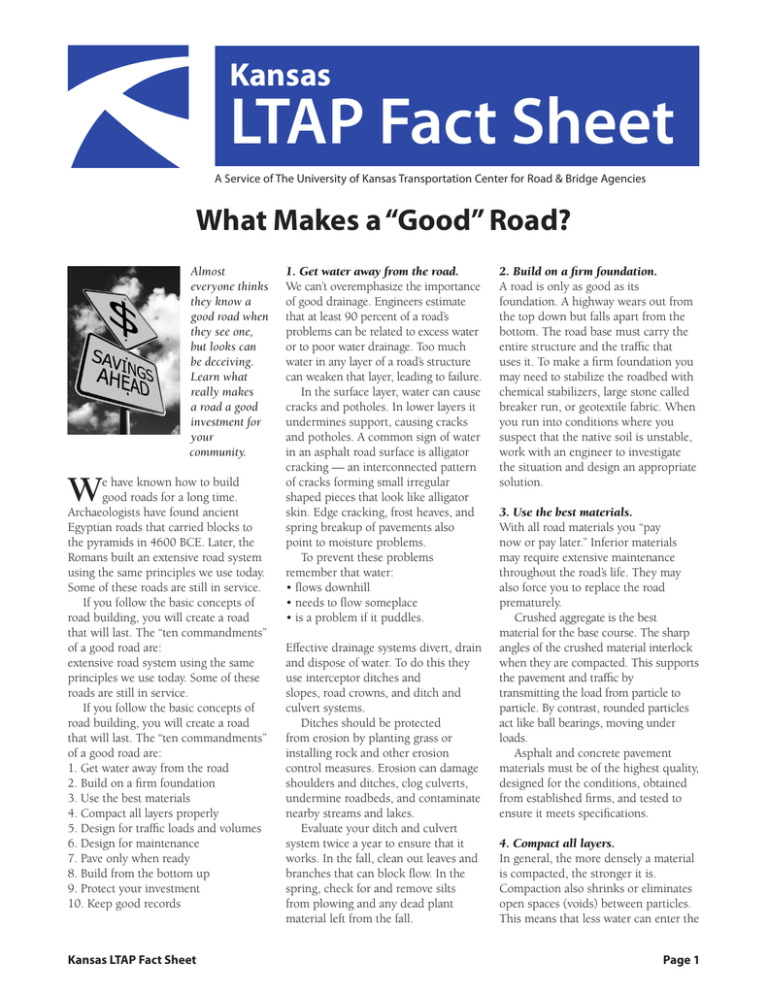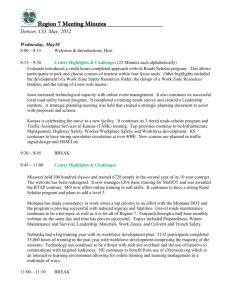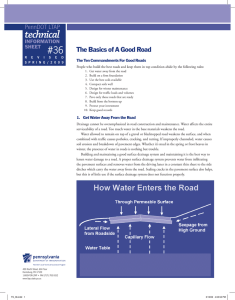What Makes a "Good" Road? - The University of Kansas
advertisement

Kansas LTAP Fact Sheet A Service of The University of Kansas Transportation Center for Road & Bridge Agencies What Makes a “Good” Road? Almost everyone thinks they know a good road when they see one, but looks can be deceiving. Learn what really makes a road a good investment for your community. W e have known how to build good roads for a long time. Archaeologists have found ancient Egyptian roads that carried blocks to the pyramids in 4600 BCE. Later, the Romans built an extensive road system using the same principles we use today. Some of these roads are still in service. If you follow the basic concepts of road building, you will create a road that will last. The “ten commandments” of a good road are: extensive road system using the same principles we use today. Some of these roads are still in service. If you follow the basic concepts of road building, you will create a road that will last. The “ten commandments” of a good road are: 1. Get water away from the road 2. Build on a firm foundation 3. Use the best materials 4. Compact all layers properly 5. Design for traffic loads and volumes 6. Design for maintenance 7. Pave only when ready 8. Build from the bottom up 9. Protect your investment 10. Keep good records 1. Get water away from the road. We can’t overemphasize the importance of good drainage. Engineers estimate that at least 90 percent of a road’s problems can be related to excess water or to poor water drainage. Too much water in any layer of a road’s structure can weaken that layer, leading to failure. In the surface layer, water can cause cracks and potholes. In lower layers it undermines support, causing cracks and potholes. A common sign of water in an asphalt road surface is alligator cracking — an interconnected pattern of cracks forming small irregular shaped pieces that look like alligator skin. Edge cracking, frost heaves, and spring breakup of pavements also point to moisture problems. To prevent these problems remember that water: • flows downhill • needs to flow someplace • is a problem if it puddles. Effective drainage systems divert, drain and dispose of water. To do this they use interceptor ditches and slopes, road crowns, and ditch and culvert systems. Ditches should be protected from erosion by planting grass or installing rock and other erosion control measures. Erosion can damage shoulders and ditches, clog culverts, undermine roadbeds, and contaminate nearby streams and lakes. Evaluate your ditch and culvert system twice a year to ensure that it works. In the fall, clean out leaves and branches that can block flow. In the spring, check for and remove silts from plowing and any dead plant material left from the fall. 2. Build on a firm foundation. A road is only as good as its foundation. A highway wears out from the top down but falls apart from the bottom. The road base must carry the entire structure and the traffic that uses it. To make a firm foundation you may need to stabilize the roadbed with chemical stabilizers, large stone called breaker run, or geotextile fabric. When you run into conditions where you suspect that the native soil is unstable, work with an engineer to investigate the situation and design an appropriate solution. 3. Use the best materials. With all road materials you “pay now or pay later.” Inferior materials may require extensive maintenance throughout the road’s life. They may also force you to replace the road prematurely. Crushed aggregate is the best material for the base course. The sharp angles of the crushed material interlock when they are compacted. This supports the pavement and traffic by transmitting the load from particle to particle. By contrast, rounded particles act like ball bearings, moving under loads. Asphalt and concrete pavement materials must be of the highest quality, designed for the conditions, obtained from established firms, and tested to ensure it meets specifications. 4. Compact all layers. In general, the more densely a material is compacted, the stronger it is. Compaction also shrinks or eliminates open spaces (voids) between particles. This means that less water can enter the Kansas LTAP Fact Sheet Page 1 Ken Skorseth photos base is 10” depending on subgrade soils. A road paved only when it is ready will far outperform one that is constructed too quickly. structure. Water in soil can weaken the structure or lead to frost heaves. This is especially important for unsurfaced (gravel) roads. Use gravel that has a mix of sizes (well-graded aggregate) so smaller particles can fill the voids between larger ones. Good compaction of asphalt pavement lengthens its life. 5. Design for traffic loads and volumes. Design for the highest anticipated load the road will carry. A road that has been designed only for cars will not stand up to trucks. One truck with 9 tons on a single rear axle does as much damage to a road as nearly 10,000 cars. Rural roads may carry log trucks, milk trucks, fire department pumper trucks, or construction equipment. If you don’t know what specific loads the road will carry, a good rule of thumb is to design for the largest piece of highway maintenance equipment that will be used on the road. A well-constructed and maintained asphalt road should last 20 years without major repairs or reconstruction. In designing a road, use traffic counts that project numbers and sizes of vehicles 20 years into the future. These are only projections, at best, but they will allow you to plan for traffic loadings through a road’s life. 8. Build from the bottom up. This commandment may seem obvious, but it means that you shouldn’t top dress or resurface a road These photos show the difference between an extremely thin base on very weak subgrade soil (top left) and a deep, good quality base if the problem is in gravel on a very sound subgrade (bottom left). The road above, in an underlying layer. South Dakota, failed after just one year because of a very poor Before you do any road base. You cannot break basic rules of planning, designing and improvement, locate construction of roads and get long-term performance. the cause of any surface problems. Choose an improvement technique 6. Design for maintenance. that will address the problem. This Without maintenance a road will may mean recycling or removing all rapidly deteriorate and fail. Design your road materials down to the native soil roads so they can be easily maintained. and rebuilding everything. Doing any This means having: work that doesn’t solve the problem is a • adequate ditches that can be waste of money and effort. cleaned regularly • culverts that are marked for easy 9. Protect your investment. locating in the spring The road system can be your • enough space for snow after it is jurisdiction’s biggest investment. Just as plowed off the road a home needs painting or a new roof, • proper cross slopes for safety, a road must be maintained. Kansas’s maintenance and to avoid snow drifts severe climate requires more road • roadsides that are planted or treated maintenance than in milder places. to prevent erosion Do these important maintenance • roadsides that can be mowed safely. activities: A rule of thumb for adequate road Surface — grade, shape, seal cracks, width is to make it wide enough for a patch, control dust, remove snow and ice snowplow to pass another vehicle Drainage — clean and repair ditches without leaving the travelled way. and culverts; remove all excess material Roadside — cut brush, trim trees and 7. Pave only when ready. roadside plantings, control erosion There is nothing wrong with a wellTraffic service — clean and repair or built and well maintained gravel road replace signs. if traffic loads and volume do not require a paved surface. Three hundred 10. Keep good records. vehicles per day is the recommended Your maintenance will be more efficient minimum to justify paving. with good records. Knowing the road’s Don’t assume that laying down construction, life, and repair history asphalt will fix a gravel road that is makes it much easier to plan and budget failing. Before you pave, make sure its future repairs. Records can also help you have an adequate crushed stone you evaluate the effectiveness of the base that drains well and is properly repair methods and materials you used. compacted. The recommended Good record keeping starts with an minimum depth of crushed stone Kansas LTAP Fact Sheet Page 2 inventory of the system. It should include the history and surface condition of the roadway, identify and evaluate culverts and bridges, note ditch conditions, shoulders, signs, and such structures as retaining walls and guardrails. Update your inventory each year or when you repair or change a road section. A formal pavement management system can help you use these records and plan and budget road improvements. Source: Nelson, Tom. “The Basics of a Good Road,” Wisconsin Transportation Bulletin no. 19, based on a fact sheet produced by the Vermont Local Roads Program. Reprinted from the Fall 2009 issue of the Kansas LTAP Newsletter, a publication of the Kansas Local Technical Assistance Program (LTAP) at the Kansas University Transportation Center. Kansas LTAP Fact Sheet Page 3



